Chittorgarh, as soon as this name struck in the mind, there are many more names appear in the memory. Red Fort may be the most talked about fort of India, but Chittorgarh has its unique place in the heart of an Indian child with its numerous stories on Rani Padmini, Raja Ratan Singh, Meera Bai, Panna Dhai, Chandan, Rana Kumbha, Rana Sanga, Rana Udai Singh, Gora-Badal, Allauddin Khilji, Emperor Akbar etc etc… When I planned this city as the third destination during bike riding in Eastern Rajasthan after Ranathambhore and Bundi, I knew, I was going in the land of romance, in the land of bravery, in the land of sacrifices to save the honor, in the land of immortality. Today, Chittorgarh is not very famous on the Indian tourist map, but you give an opportunity to any school going kid in India, he will instantly grab that. Rajputs were famous for the patriotism and self respect and these was the stories from the Chittor and Mewar, which gave them that fame.
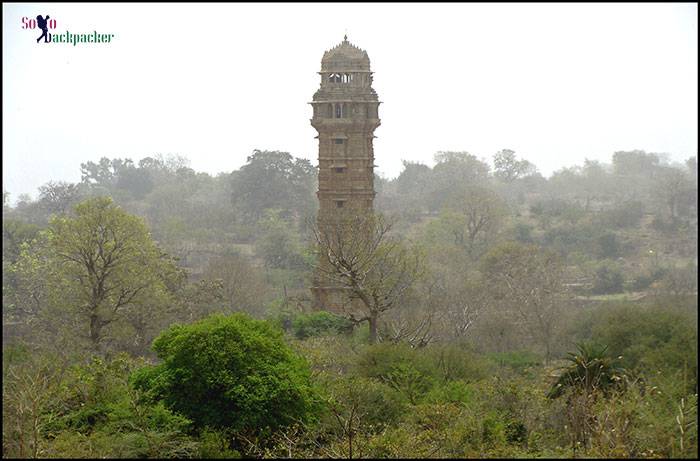
I started my journey from Bundi in the afternoon and after 150 kms of riding, I reached to Chittorgarh around 5 PM. I booked the hotel already, so straight went to the hotel and took a sleep of 2 hours. In the evening, I explored the city of Chittor and later on the next day morning I visited the mighty fort of Chittorgarh.
The city of Chittor is lies on the bank of Berach River, a tributary of the Banas River. It served as the capital of Mewar. The Chittor fort is situated on the top of a hill at the height of 180 meters and spread in the area of 692 acres.This is the largest fort in India and also in Asia. This mighty fort was almost invincible in the history of Rajputana and initially ruled by Guhilot and later by Sisodias, the Suryavanshi clans of Chattari Rajputs, from 7th century, until it was finally abandoned in 1568, after the siege by Emperor Akbar in 1567. This fort was built by Mauryans in 7th century, but the famous stories circle around the Rajputana Rulers. This is a fort where you can drive to and this is also a fort where you can drive through; the only one I visited in India till now.
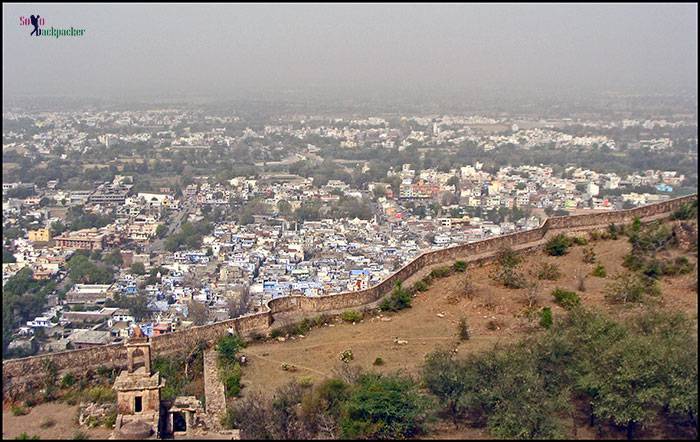
Visiting the Fort:
A winding hill road of more than 1 km length from the new town leads to the west end main gate, called Ram Pol, of the fort. The fort has seven gates (in the local language, gate is called “Pol”), namely the Padan Pol, Bhairon Pol, Hanuman Pol, Ganesh Pol, Jodla Pol, Laxman Pol and the main entry gate of Ram Pol (Lord Rama’s Gate). All the gateways to the fort have been built as massive stone structures with secure fortifications for military defense. The doors of the gates with pointed arches are reinforced to fend off elephants and cannon shots. The top of the gates have notched parapets for archers to shoot at the enemy army. A circular road within the fort links all the gates and provides access to the numerous monuments in the fort.
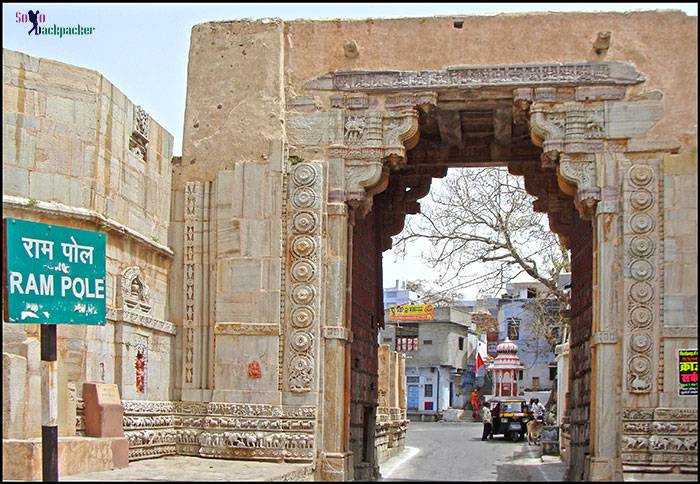
Driving inside the fort is the best part of visiting such a large fort area in 3-4 hours. If you wish, you can walk also; but it will take one full day to visit all the attractions. The fort, encompassing beautiful temples, imposing royal palaces, commanding towers and hundreds of ruins, is an echo of a past that was glorious in its reaches and rich in its architecture and traditions and everything has its own set of story. Unless you are aware of the history, hiring a guide is recommended. The local guides who know fluent Hindi and a bit of English are easily available near the ticket counter and they charges from Rs.250 to Rs. 500 for a day.
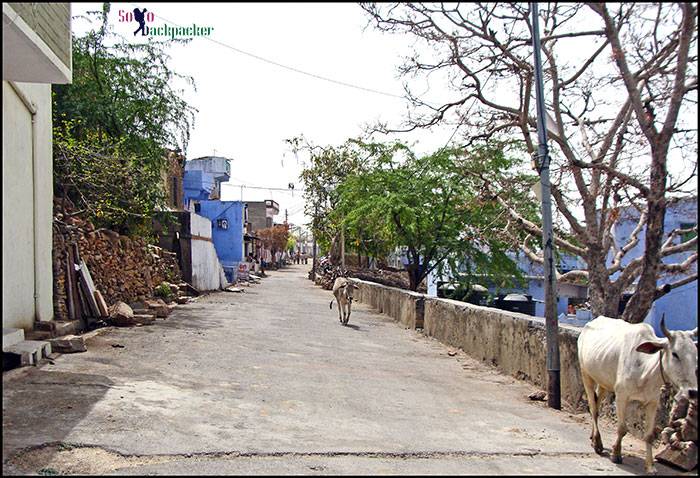
Tickets: Rs.5 for Indian nationals, Rs.100 for foreign tourists. Ticket counter is inside the fort near Rana Kumbha’s Palace. Rs. 5 is the parking charge for a bike. Once you buy a parking ticket at any of the parking area within the fort, you can use that at all subsequent parking area.
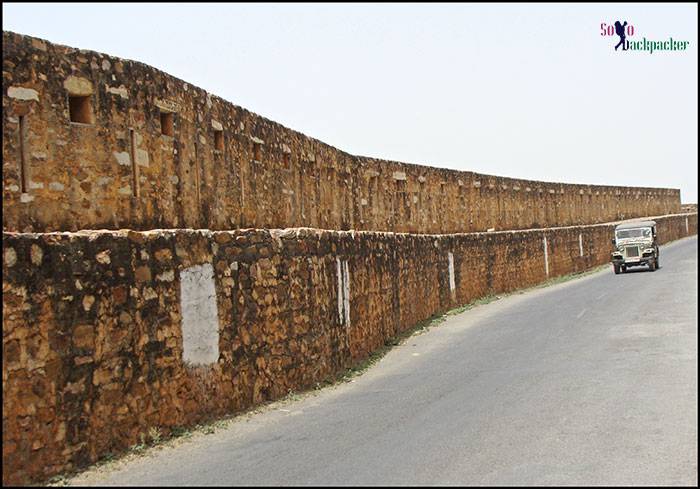
Water Fort: This fort was always under the threat of siege; it had to be well equipped with a strong water supply to sustain it for a long time. The fort that once boasted of 84 water bodies has only 22 now. These water bodies are fed by natural catchment and rainfall and have a combined storage of 4 billion litres that could meet the water needs of an army of 50,000. The supply could last for four years. These water bodies are in the form of ponds, wells and step wells and built close to residences, palaces and havelis. Due to its strong water supply system, this fort is also known as”water fort.”
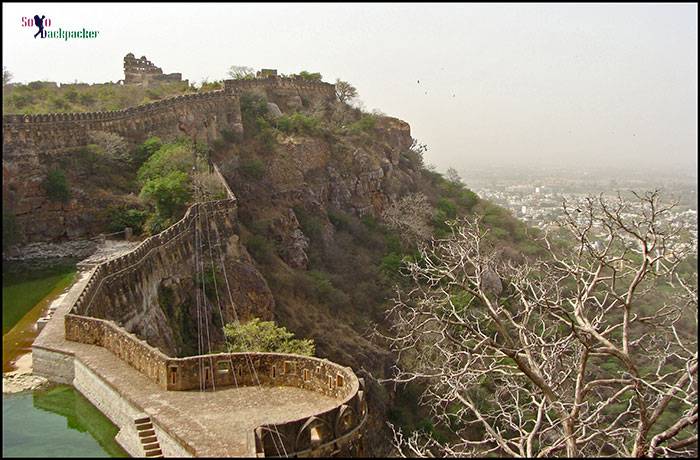
Legendary Stories of Chittorgarh:
Before taking you to the virtual tour of the fort, I would like to share the interesting stories of the romance, beauty, chivalry and sacrifices,that set the stage for drama after drama played out within the wall of this gigantic fort. Without knowing these stories, you cannot feel the very essence of the historic times that it has survived and evolved through, preserving its stories in sunlit sheen of sandstone.
Meerabai and her passionate devotion to the Lord Krishna: Meera was a Rajput princess. One day when she was playing outside her house, a saint came with the idol of Shri Krishna. After seeing the idol, she was inconsolable until she possessed it and probably kept it all her life. Thereafter, Meera spent most of her time playing with the idol and eventually, developed tremendous devotion for Sri Krishna. One day the little girl Meera went to her mother after playing a game of bride-groom. Innocent Meera asked about her future husband, and prankly her mother said that her husband would be Lord Krishna. From that time onwards, she considered herself as a spouse of Lord Krishna.
Meera’s marriage was arranged at an early age, traditionally to Prince Bhoj Raj, the eldest son of Rana Sanga of Chittor. She was not happy with her marriage as she considered herself already married to Krishna. Her new family did not approve of her piety and devotion when she refused to worship their family deity- Tulaja Bhawani(Durga).Unfortunately, when she was in her twenties, her husband died in a battle. She appears to have despaired of loving anything temporal and turned to the eternal, transforming her grief into a passionate spiritual devotion that inspired in her countless songs drenched with separation and longing.
Meera’s love to Krishna was at first a private thing but at some moment it overflowed into an ecstasy that led her to dance in the streets of the city. Her brother-in-law, Vikramaditya, the new ruler of Chittorgarh, was against her devotion to Krishna. According to some myths, he tried to harm Meera in many ways, such as:
- The famous one is that he mixed poison in the prasadam or chandanamritam of Krishna and made her drink it. But by God’s grace, Krishna changed it to Amrit (nectar).
- He pinned iron nails in Meera’s bed, but, again by God’s grace they turned into rose petals.
-
He placed a snake among the flowers she used for her daily worship offering. During the worship, Meera was so lost in her devotion to Sri Krishna that she failed to notice the poisonous snake. But, when Meera put her hand in the flower basket the snake instantly turned into a garland!
Later, Meera declared herself a disciple of the Guru Ravidas from Varanasi. She left for the pilgrimage and danced from one village to another village, almost covering the whole north of India. She seems to have spent her last years as a pilgrim in Dwarka. It is said that Mirabai disappeared into the Dwarkadhish Murti (Image of Lord Krishna) in front of a full audience of onlookers.
Panna Dhai, who sacrificed her son to complete her duty: Panna Dhai was the caretaker of Prince Udai Singh, lawful heir to the throne of the royal Mewar dynasty. She had practically played the role of a mother for the baby, breast-feeding him from birth and taking care of him along with her own son (Chandan), who was almost of the same age.
The political scenario of the Mewar throne, however, was very uncertain at this time. A distant cousin of the ruling dynasty, Banbir, was the operational regent for the throne and had the teenage crown prince Vikramaditya under house arrest because of his juvenile ways while at the seat of power. Banbir thought that he could usurp the throne amidst all this turmoil and therefore, one night he organized the festival of Deepadan (Donation of Lamps). While the other people of the palace were busy in the celebration, he murdered Vikramaditya.
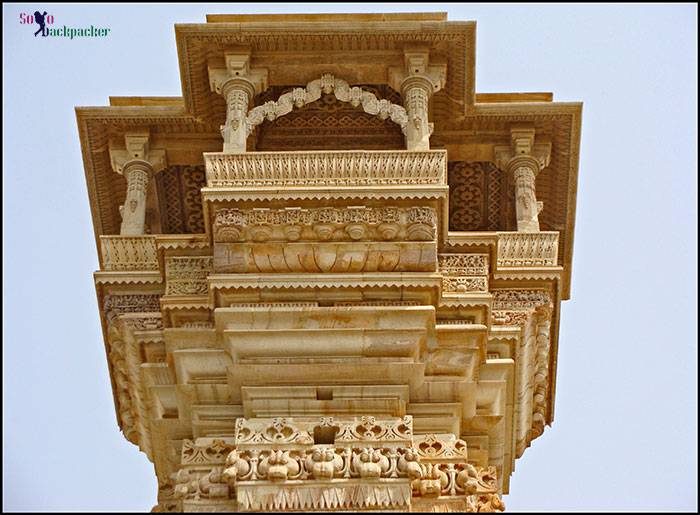
Now the last barrier of his way to the crown was Prince Udai Singh. With the bloody sword, he approached towards the prince’s palace which was in Bundi, but the news of his approach reached Panna Dhai earlier. The faithful servant of the royal family took the decision in a moment with a supreme courage and patriotism. She swapped the two babies in the royal cradle, where was the prince and the ordinary one, where her own son, Chandan, lay fast asleep. Banbir reached there and asked about the prince. Panna pointed her finger towards the royal cradle, where her own son was sleeping. Panna Dhai had stood there in horror as her own son was butchered in front of her own eyes.
With the help of another faithful servant, Pannai took Udai Singh to Kumbhalgarh. He lived in secret in Kumbhalgarh for two years, disguised as a nephew of the governor Asha Shah. In 1540, he was crowned in Kumbhalgarh by the nobles of Mewar. The young prince came back and claimed his right to the throne, after defeating Banbir in a battle who was never spotted again. Panna Dhai quietly went back into the oblivion of history.
Legendary Burning Pyres (Jauhar) of Chittor:
Story of Rani Padmini, Gora and Badal:The first defeat befell Chittorgarh in 1303 when Ala-ud-din Khilji, the Sultan of Delhi, besieged the fort, to capture the beautiful Rani Padmini, wife of Rana Ratan Singh. It is said that Rani Padmini’s beauty had enticed Ala-ud-din Khilji to invade Chittorgarh. This resulted in a battle between Khilji and Ratan Singh.
The fort was under siege for seven months. It is believed that when both sides were exhausted, Ala-ud-din Khilji crafted a sly plan. He asked Ratan Singh for a glimpse of his wife Rani Padmini in return of lifting the siege over Chittor. Khilji was taken into Padmini’s palace in the midst of a lake and Padmini’s reflection was shown to him in a mirror as she sat down on the steps of the Jal mahal. Khilji then asked Rana Ratan Singh to accompany him to the last gate of the fort where he was outnumbered and captured by the Sultan’s army. Khilji demanded Padmini in return of her husband’s freedom. A war council was held in which Padmini herself decided that Ratan Singh had to be rescued. The heroics were left to Gora and his nephew Badal who devised a plan for Ratan Singh’s liberation. Word was sent out to the Khilji camp that Padmini would be delivered to him the day his army pulled out of their trenches. But there was a catch – her entourage of female servants and friends would accompany Padmini in 50 palanquins.
The palanquin’s were armed with the best of the Rajput warriors with two swords each. When Padmini’s palanquin, which was occupied by Gora, reached Ratan’s tent, he asked Rawal to mount the horse and go back to the fort. Then Gora gave a signal and all the Rajput warriors came out of their palanquins and attacked the Muslims cutting them to pieces. Gora reached Khilji’s tent and was about to kill the sultan when Khilji moved his concubine in front of himself. Gora, being a Rajput, could not kill an innocent woman and these few seconds were enough for Khilji’s guards to kill Gora from behind. But still Ratan Singh was out of their hands. Beaten, Ala-ud-din returned to Delhi, only to come back better equipped early the next year. The Rajput defence failed as a result of this second attack and the Rajput warriors perished on the battlefield, while their womenfolk, led by Maharani Padmini, performed Jauhar by jumping into the burning pyres.
Second Jauhar of Chittor: Rana Sanga died in 1528 AD after the Battle of Khanua. Shortly afterwards, Mewar and Chittor came under the regency of his widow, Rani Karnavati. The kingdom was menaced by Bahadur Shah of Gujarat, who besieged Chittorgarh. Without relief from other forces and facing defeat, the Rani committed Jauhar with other women on March 8, 1535 A.D. while the Rajput army braved out to meet the besieging Muslim army.
According to one legend, Karnavati requested the assistance of Humayun, the son of Babar, her late husband’s foe, by sending him a Rakhi and a request for his help as a brother. The help arrived too late. This is the occasion for the second jauhar performed at Chittor.
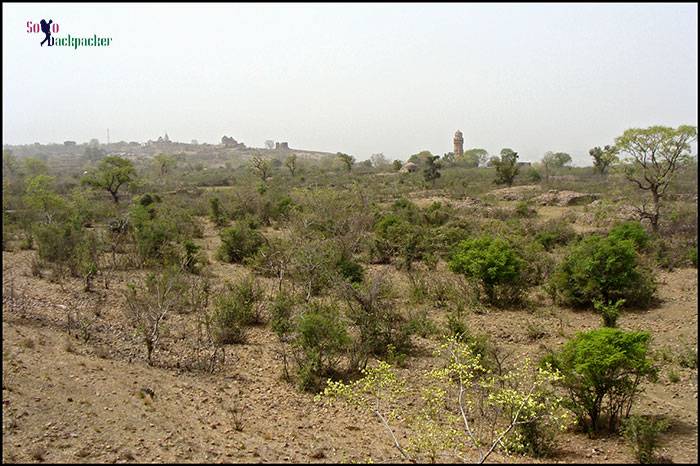
How to Reach Chittorgarh:
By Road:
Situated at the intersection of NH 76 and NH 79, Chittorgarh is well connected to all parts of India by roads. The Golden Quardilateral Road Project and North-South-East-West corridor expressway passes through Chittorgarh City. The bus stand of Chittorgarh is located in the mid of old and new city. The distance of bus stand from major hotels is around 0.1 Km to 2 Km. Fort of Chittorgarh is around 2 Km and train station is around 2 Km. There are good bus services (Private as well as government) available for Delhi (565 kms), Mumbai (862 kms), Ahamadbad (375 kms), Ajmer (190 kms), Jaipur (309 kms), Bundi (146 kms), Kota (170 kms), Udaipur (120 kms), Bhilwara (54 kms) and other major cities.
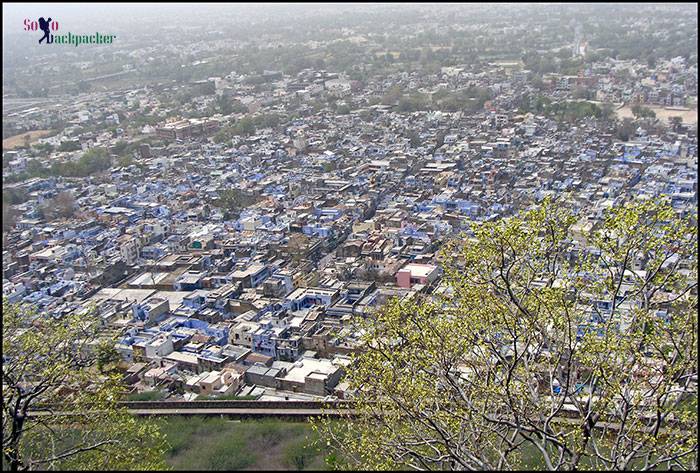
Rajasthan State Road Transport Corporation (RSRTC) provides a very good service for visiting areas around Chittorgarh. Rajasthan Roadways also has a premier service called Pink Line, Silver line and Sleeper Coaches (Gray Line).
For more detail about Rajasthan Roadways service please call on following numbers:
General Enquiry: 01472-241177
Station Master: 01472 – 241038
By Train:
Chittorgarh railway station is a junction of western indian railways. It has rail links with Ahmedabad, Ajmer, Udaipur, Jaipur, Kota and Delhi.
For the train details, time table and reservation status, visit Indian Railway Website: www.indianrail.gov.in
For online reservation, visit IRCTC website: www.irctc.co.in
By Air:
The nearest airport is Udaipur(Dabok Airport). The airport is around 90 kms from Chittorgarh City and linked by daily Air Service from New Delhi, Jaipur, Jodhpur, Ahmedabad and Mumbai. Kingfisher Airlines, Air India and Jet Airways has daily flights between Delhi and Udaipur.
Accommodation: Online hotel can be book at various online hotel booking portals. If you want to book the hotel after reaching Chittorgarh, then also there is no problem. Chittor has a good number of hotels. You can visit both the above-mentioned website to get an idea about the prices before visiting. This will help you in good bargaining.


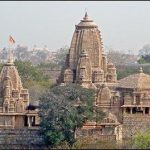
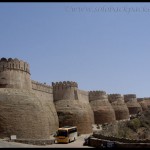
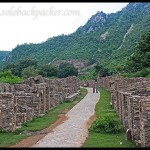
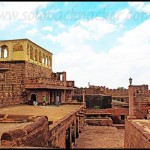
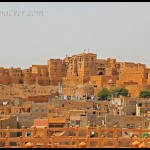
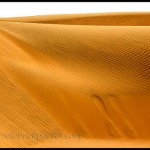
Such an amazing post on Chittorgarh Fort . I am from Rajasthan and this post added much information to my existing bucket of knowledge about heritage of Rajasthan. Great Work. Keep It Up.
Beautiful post, I am planning to visit there..
Hi even we too with my family had a wonderful moments over there in the choittorgarh fort day and night..!
I have long dreamed of exploring India by motorcycle and I am so inspired reading and looking at the images on this post. When reading up on the fort and the town for our upcoming trip I was always fascinating by the stories of Meerabbi and took it to be an inspiration, so I hope to be there soon and follow in your footsteps!
Thank you. I enjoyed reading this and perusing your photos.
good information. we are planning to visit this shortly. will be very useful. thanks
Very Valuable post, thanks a lot!!
nice post. glad to see people like u who devote their time to these precious remnants of history.
Thanks sir…
you have captured the information brilliantly… impressive work with photographs….
Interesting…
hyderabadonnet.com
Nice post, I also had a fantastic time visiting the town…
Thanks Sid..Do visit the second part of this blog..http://www.solobackpacker.com/2012/04/10/romance-with-the-ruins-of-chittorgarh-fort-part-22/